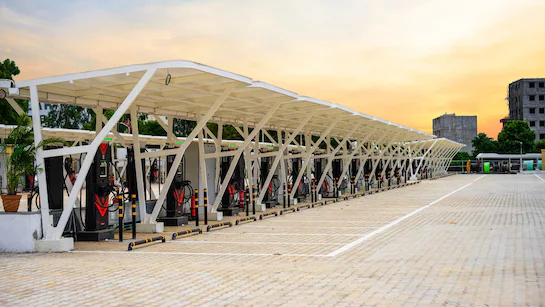In an era where sustainability and speed are reshaping our transportation landscape, the rise of fast-charging networks is a game-changer for electric vehicles (EVs). Did you know that in 2023, the number of fast-charging stations globally surpassed 500,000, according to Bloomberg Green? This rapid expansion is a testament to the increasing demand for efficient charging solutions that meet the needs of modern EV users. In this article, you’ll discover how fast-charging networks are influencing the future of electric mobility, making EVs more accessible, convenient, and appealing to consumers worldwide.
The Rise of Fast-Charging Networks: A New Era in Electric Mobility
The Current Landscape of EV Charging Infrastructure
As of 2023, the global EV market is booming, with over 10 million electric vehicles sold annually, according to InsideEVs. This surge has been matched by the growth of fast-charging networks, which are crucial for addressing the range anxiety often associated with electric driving. Fast chargers, also known as rapid chargers, can replenish an EV’s battery in as little as 30 minutes—a stark contrast to traditional home charging that can take several hours.
Key Features of Fast-Charging Networks:
- Speed: Charging speeds of up to 350 kW, allowing for quick battery top-ups.
- Accessibility: Stations strategically located along major highways and urban centers.
- Compatibility: Support for multiple EV models and charging standards.
Major Players in Fast-Charging Infrastructure
Several companies are leading the charge in building robust fast-charging networks. Tesla’s Supercharger network remains a pioneer, boasting over 40,000 stalls worldwide. Meanwhile, companies like Ionity in Europe, ChargePoint in North America, and BYD in Asia are expanding their footprints, offering diverse options for EV owners.
Tesla Superchargers
- Network Size: Over 40,000 stalls globally.
- Charging Speed: Up to 250 kW.
- Unique Features: Exclusive to Tesla vehicles but opening up to all EVs in select locations.
Ionity
- Network Size: 500 fast-charging stations across Europe.
- Charging Speed: Up to 350 kW.
- Unique Features: Focus on sustainable energy sources.
The Technological Advancements Fueling Fast Charging
Fast-charging technology is evolving rapidly, with innovations that promise even quicker charging times and greater efficiency. According to Wired, developments in solid-state batteries and ultra-fast charging stations are on the horizon, potentially reducing charging times to under 15 minutes.
Innovations to Watch:
- Solid-State Batteries: Offering higher energy density and faster charging capabilities.
- Wireless Charging: Emerging as a convenient alternative with ongoing trials by brands like Hyundai.
- Grid Integration: Using smart grids to optimize power distribution and reduce costs.
Practical Tips for Navigating Fast-Charging Networks
How to Charge Your EV Efficiently
- Plan Your Route: Use apps like PlugShare or Tesla’s built-in navigation to locate fast-charging stations.
- Optimize Charging Times: Avoid peak hours to minimize wait times and take advantage of off-peak rates.
- Understand Your EV’s Capabilities: Familiarize yourself with your vehicle’s maximum charging speed to manage expectations.
Where to Buy and Compare Charging Solutions
- Online Platforms: Websites like Electrek and CleanTechnica offer comprehensive reviews and comparisons of different charging networks.
- Dealerships: Many EV manufacturers, such as Nissan and Ford, provide valuable insights and deals on compatible chargers.
- Public Forums: Join communities like Reddit’s r/electricvehicles for firsthand experiences and recommendations.
Comparing Fast-Charging Networks
| Network | Coverage | Speed | Unique Selling Point |
|---|---|---|---|
| Tesla | Global | Up to 250 kW | Seamless integration with Tesla |
| Ionity | Europe | Up to 350 kW | Focus on renewable energy |
| ChargePoint | North America, Europe | Up to 200 kW | Extensive network partnerships |
| EVgo | United States | Up to 350 kW | Solar-powered stations |
The Future of Fast-Charging Networks: A Vision for Tomorrow
Fast-charging networks are not just a convenience; they are a catalyst for the broader adoption of electric vehicles. By reducing charging times and increasing accessibility, these networks are making EVs a viable option for more consumers, particularly those in urban areas where home charging may not be feasible.
Key Takeaways:
- Expansion and Accessibility: Expect continued growth in fast-charging infrastructure, with more stations in rural and underserved areas.
- Technological Innovations: Look forward to breakthroughs in battery technology that will further reduce charging times.
- Environmental Impact: Fast-charging networks are increasingly powered by renewable energy sources, further enhancing their sustainability.
In conclusion, fast-charging networks are a critical component of the future of electric mobility, shaping how we drive, charge, and think about transportation. As these networks expand and improve, they pave the way for a cleaner, more efficient, and more connected world. Are you ready to make the switch to an electric future? Share your thoughts and experiences in the comments below, and let’s explore this electrifying journey together!

